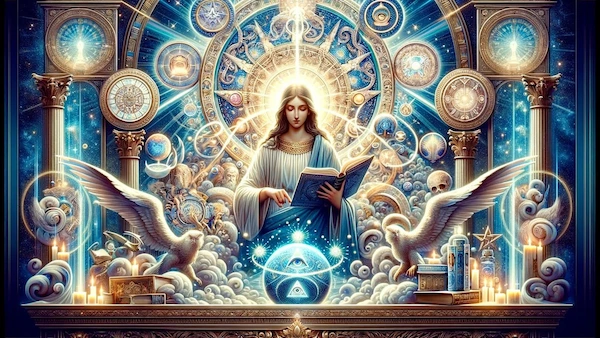
Introduction: Connecting With the Afterlife
The age-old desire to communicate with the deceased is a hallmark of the human condition, reflecting profound existential questions about life, death, and what lies beyond. This yearning transcends cultural boundaries and historical periods, emerging from our deepest contemplations of mortality and the enduring nature of consciousness. Far more than mere curiosity, this impulse speaks to fundamental aspects of human psychology—our need for continuity, meaning, and the persistence of bonds formed in life. This exploration delves into the intricate history of spirit communication, examining its philosophical underpinnings, diverse cultural expressions, the psychological motivations that drive individuals to seek these connections, and the complex spiritual risks that such practices may entail.
Historical Context of Communicating With the Dead
Ancestral Worship: The Dawn of Belief Systems
Spirit communication finds its origins in humanity’s earliest spiritual awakenings. In prehistoric societies, the conceptual boundaries between the living and dead remained permeable, with ancestral veneration forming the cornerstone of communal identity and spiritual practice. Archaeological evidence from Neolithic burial sites reveals elaborate interments containing pottery, tools, and personal ornaments—not merely as tributes but as essential provisions for the deceased’s journey into the afterlife.
These ancient practices reflected a sophisticated cosmology where ancestors occupied an intermediary realm between the living and the divine. The Sumerians, with their complex pantheon and mythologies, conceived of the afterlife as the “Land of No Return,” a realm where the deceased continued a shadow existence. Their priests served as mediators between worlds, conducting elaborate rituals that maintained cosmic order while providing a channel for ancestral guidance. This foundational belief system established a precedent for understanding death not as an endpoint but as a transformation of relationship—a concept that would resurface across diverse cultures throughout human history.
The social implications of these practices were profound. By maintaining communication with ancestral spirits, early societies created mechanisms for preserving cultural knowledge, enforcing social norms beyond the lifespan of individual members, and providing psychological continuity in the face of life’s inevitable transitions. These practices suggest that our earliest ancestors recognized that what endures after death may be as significant as what exists during life.
Ancient Egypt: Cosmologies of the Afterlife
Egyptian civilization elevated funerary practices and communication with the dead to unprecedented sophistication. Their elaborate belief system viewed the soul as eternal, capable of traversing the boundaries between worlds. The “Book of the Dead”—more accurately translated as “The Book of Coming Forth by Day”—provided a comprehensive guide not only for the deceased’s journey but also for the living who sought to maintain contact across the threshold of mortality.
The mummification process itself embodied profound metaphysical concepts. By preserving the physical vessel, Egyptian embalmers created an enduring anchor for the ka (life force) and ba (personality) aspects of the soul. The meticulous removal and separate preservation of organs, the application of natron for desiccation, the elaborate wrapping rituals accompanied by incantations—all served to create a permanent bridge between worlds. During the critical weighing of the heart ceremony, where the deceased’s heart was balanced against the feather of Ma’at (truth and cosmic order), family members would actively invoke protective deities while leaving sustenance offerings that maintained reciprocal relationships transcending physical boundaries.
These practices extended beyond personal grief to structure Egyptian society itself. Temples maintained perpetual offering schedules for deceased pharaohs, while ordinary families devoted considerable resources to maintaining ancestral cults. The significance of these communications was not merely emotional but practical—neglected ancestors were believed capable of causing misfortune among the living, while properly honored ancestors provided protection and guidance.
Most intriguingly, Egyptian conceptions of the afterlife reflected their understanding of consciousness itself. The division of the soul into multiple components—ka, ba, akh, and others—suggests an intuitive recognition of consciousness as complex and multidimensional, capable of existing in different states simultaneously. This sophisticated psychology of the afterlife created a framework where communication between realms was not merely possible but essential for maintaining cosmic harmony.
The Birth of Spiritualism and the 19th Century Renaissance
The 19th century witnessed a remarkable resurrection of interest in spirit communication, catalyzed by unprecedented social turmoil and intellectual ferment. The Industrial Revolution had transformed social structures while challenging traditional religious frameworks, and catastrophic death tolls from the American Civil War, European conflicts, and disease epidemics left societies collectively traumatized. Within this context, Spiritualism emerged as both a response to grief and a philosophical rebellion against materialist science.
The Fox sisters’ alleged communication with a spirit in their Hydesville, New York home in 1848 captured the popular imagination at precisely the historical moment when traditional religious explanations were being questioned. Their demonstrations—featuring mysterious rappings interpreted as spirit messages—precipitated a movement that would transform Western attitudes toward death. Séances became popular gatherings where participants from various social classes communed with departed loved ones, effectively democratizing mystical experiences previously confined to religious authorities.
Allan Kardec’s systematic approach to spirit communication, detailed in “The Spirits’ Book” (1857), introduced a hierarchical cosmology where spirits existed in various stages of evolution. His framework presented spirit communication not merely as consolation for the bereaved but as an educational process whereby advanced spirits could guide humanity toward ethical enlightenment. Kardec’s codification of what became known as Spiritism drew upon both empirical observation and rationalist philosophy, creating a spiritual system that appealed to intellect and emotion alike.
Significantly, the Spiritualist movement challenged existing power structures. Women, typically marginalized within traditional religious hierarchies, emerged as prominent mediums, gaining unprecedented public platforms and often financial independence. Spiritualism’s emphasis on direct experience over dogma attracted freethinkers, abolitionists, suffragists, and those disillusioned with established religions, creating community spaces where progressive ideas flourished alongside communications with the dead.
Early 20th Century Developments: Theosophy and Beyond
The early 20th century witnessed a synthesis of Eastern and Western approaches to spirit communication through the Theosophical Society, founded by Helena Petrovna Blavatsky and others. Theosophy incorporated elements of Hinduism, Buddhism, and Western esoteric traditions, presenting a universal approach to mortality and consciousness that transcended cultural boundaries. Concepts like karma and reincarnation offered sophisticated frameworks for understanding the relationship between the living and the dead.
This period also marked the emergence of scientific investigation into mediumship. Organizations like the Society for Psychical Research, founded in London in 1882, applied rigorous empirical methods to paranormal claims. Scientists including William James and Sir Oliver Lodge conducted controlled experiments with mediums, investigating ectoplasm manifestations, automatic writing, and trance communications. These investigations represented a significant attempt to bridge empiricism and metaphysics, challenging the growing division between scientific and spiritual worldviews.
Meanwhile, specialized schools of mediumship emerged, particularly in England and America, where psychic abilities were cultivated through disciplined practice. The Spiritualist community developed ethical guidelines for mediumship, emphasizing responsibility in facilitating communications from beyond the veil. What had begun as spontaneous phenomena evolved into organized spiritual practices with institutional structures that preserved and transmitted these methods across generations.
Literature of this period reflected this cultural fascination. Authors like Arthur Conan Doyle (himself a committed Spiritualist) incorporated themes of spirit communication into their works, while philosophical texts explored the implications of survival beyond bodily death. This literary engagement helped normalize discourse about the afterlife, creating space for both belief and skepticism within mainstream cultural conversation.
Philosophical and Spiritual Dimensions
The Existential Inquiry Into Life and Death
Communication with the deceased inevitably engages profound existential questions about consciousness, identity, and the meaning of mortality itself. Philosophers have long recognized that our understanding of death fundamentally shapes our experience of life. Søren Kierkegaard’s concept of the “leap of faith” illuminates how spirit communication represents a profound wager on meaning beyond empirical certainty—an act that acknowledges finitude while simultaneously transcending it through the possibility of continued connection.
Kierkegaard’s assertion that “the more we are aware of our own mortality, the more we seek to connect with that which endures” encapsulates the existential paradox driving spirit communication. By acknowledging death’s inevitability while seeking connection beyond it, individuals engage in a distinctly human form of transcendence—neither denying mortality nor surrendering to nihilism, but finding meaning in the tension between limitation and possibility.
Martin Heidegger’s concept of “Being-toward-death” suggests that authentic existence requires embracing rather than evading our mortality. From this perspective, genuine spirit communication might represent not an attempt to deny death but rather a more profound engagement with its reality and implications. By confronting the possibility that consciousness transcends physical dissolution, individuals may develop what Heidegger termed “anticipatory resoluteness”—the capacity to live more authentically in light of finitude.
Eastern philosophical traditions offer complementary perspectives on communicating with the dead. Buddhism’s concept of impermanence (anicca) rejects fixed identity, suggesting that attachment to permanent selfhood generates suffering. From this perspective, communication with the deceased might be understood not as contacting separate entities but as recognizing the interconnected nature of consciousness itself. The Buddhist emphasis on mindfulness parallels certain approaches to mediumship that prioritize heightened awareness over conceptual frameworks.
Cultural Interpretations and Ritual Practices
Cross-cultural examination reveals diverse approaches to spirit communication, each shaped by historical contexts and metaphysical frameworks. These variations illuminate not only different techniques for bridging worlds but also profound differences in how cultures conceptualize death, memory, and the boundaries of selfhood.
In traditional Chinese culture, ancestor veneration is deeply integrated into family structure and identity. The Qingming Festival (Tomb-Sweeping Day) serves as a formalized occasion for families to honor ancestors by visiting graves, cleaning tombstones, and leaving offerings of food and symbolic money. These practices reflect belief in reciprocal relationships that transcend death—the living provide sustenance to ancestors who, in turn, offer protection and guidance. Rather than emphasizing individual communication, Chinese traditions emphasize collective family connections maintained across generations.
In Māori culture of New Zealand, the connection to ancestors (tūpuna) remains integral to cultural identity and decision-making. The concept of whakapapa (genealogy) creates an unbroken lineage between the living and the dead, while ceremonial practices like pōwhiri (welcome ceremonies) actively invoke ancestral presence. When important decisions affecting the community arise, ancestral guidance is sought through communal gatherings where experienced elders may serve as conduits for ancestral wisdom. This approach emphasizes spirits’ continuing role in community governance rather than merely providing comfort to bereaved individuals.
Mexico’s Día de los Muertos (Day of the Dead) exemplifies a celebration where communication with the deceased becomes joyful rather than somber. Families construct elaborate ofrendas (altars) featuring photographs, favorite foods, and possessions of the deceased, creating sensory bridges between worlds. Marigold flowers, with their distinctive scent, are believed to guide spirits back to the earthly realm, while copal incense purifies pathways between dimensions. This approach emphasizes continuity and celebration rather than separation and mourning, suggesting that death transforms rather than terminates relationships.
Even in contemporary Western culture, artistic representations of spirit communication reflect evolving attitudes toward mortality. Films like “Ghost” (1990) and novels such as “The Lovely Bones” (2002) present spirits as maintaining emotional connections and unfinished business with the living. These narratives often portray communication across the veil as potentially healing for both the living and the deceased, suggesting that mainstream Western culture increasingly views death as a transition rather than an endpoint—a perspective that aligns with both ancient wisdom traditions and contemporary near-death research.





